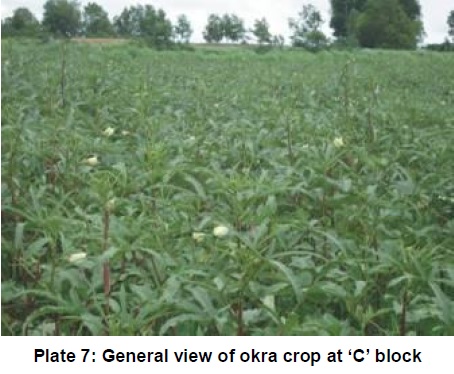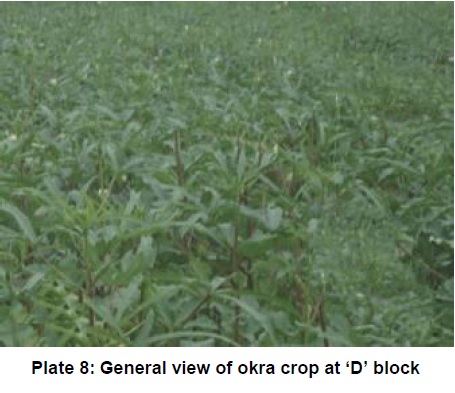An investigation was carried out at Main Agricultural Research station, University of Agricultural Sciences, Dharwad, Karnataka during monsoon season 2012, to study response of okra (Abelmoschus esculentus var. Arka Anamika L. Moench) to Homa Organic Farming practices.
Preamble
A field experiment laid out in completely randomised block design with 18 treatments replicated thrice was conducted during monsoon season 2012 to study the biochemical efficacy of Homa organic farming practices in okra (Abelmoschus esculentus var. Arka Anamika). |
 |
 |
| The conventional control (CC) and control without homa (CWH) were maintained almost 1 km away. The soil type was red black. The non-homa ash was collected after burning the agricultural waste. In the field where okra crop was grown, two homas (Yajnya) were performed daily i.e. Agnihotra homa at sun rise and sun set and Om Tryambakam homa daily at any time during the day for 3-4 hours, except at Agnihotra time. Agnihotra homa ash, Om Tryambakam homa ash and Non-homa ash were used as soil and foliar application @ 41.5 kg per ha and a special bio-digester called Gloria Biosol was prepared and used for soil and foliar application @ 1850 liters per ha at 30, 45, 60 and 75 DAS. Other liquid organic bio-digesters i.e. Panchgavya (5%) and Jeevamruta (550 liters /ha) were used individually and in different combinations with homa products like homa ashes and Non-homa ash for soil and foliar application. |

 |
Discussion
Soil and foliar application of GB was significantly superior over organic control in yield attributes. Significant increase in microbial population in soil, ctivities of soil dehydrogenase and phosphatase was observed. Macro and micro nutrient status of soil and okra fruits in homa treatments was significantly superior over organic control. Glaring increase was observed in okra fruits in its ascorbic acid content and in P (58%), K (98%), Cu (52%), Zn (48%), Mn (17%) and Fe (23%) contents over organic control. Significant reduction was observed in the incidence of powdery mildew (36%), alterneria leaf spot (57%), insect attack by fruit borer (38%) and Spodoptera litura larvae per plant (68%) due to soil and foliar application of GB and different homa treatments. |
 |
Summary and Conclusions
- Morphological characters like plant height, number of leaves per plant, leaf area, dry matter production, and number of branches were found to be enhanced due to different homa treatments.
- Physiological Characters like shelf life, fruit colour of okra etc. were found to be enhanced by different homa and Non-homa treatments.
- Noteworthy was increase in okra yield by 36 per cent due to Gloria Biosol treatment (15.03 t/ha) which was the best among homa treatments against conventional control (11.02 t/ha) and showed 28 per cent increase over Non-homa control (11.76 t/ha) and 21 per cent over homa organic control (12.38 t/ha).
- Soil available macro nutrient status registered increase in macro nutrients (N, 18-31 %; P, 49-84% and K, 22-26%) exposed to homa atmosphere due to different homa treatments over conventional control.
- Soil micro nutrient status also registered increase (Cu, 8-13%; Zn, 19-31%; Mn, 5-27% and Fe, 8-22%) due to different homa treatments as compared to conventional control not
exposed to homa atmosphere.
- Increase in the population of bacteria (29-42%), fungi (13-70%) and Actinomycetes (15-67%) in the soil was observed due to different homa treatments including Gloria Biosol as compared with conventional control.
- Significant increase in the activities of soil dehydrogenase (12-58%) and phosphatase (8-14%) was observed in different homa treatments as compared with conventional control.
- Increase in quality parameters of okra like ascorbic acid (0.5-34%), phenols (2-8%), nitrogen (3-28%), phosphorus (4-58%), potassium (45-98%), micronutrients like Cu, Zn, Mn and Fe (51-52%, 31-48%, 3-17% and 2-23%, respectively) was registered due to different homa treatments as compared to conventional control not exposed to homa atmosphere at crop harvest stage.
- Decrease incidence of Powdery mildew (19-36%) and Alterneria leaf spot (30-57%), fruit borer (16-38%), and Spodoptera litura larvae per plant (48-68%) were observed due to different homa treatments as compared with conventional control.
- Soil and foliar application of Gloria Biosol was found to be more effective than other homa treatments. Soil and foliar application of Om Tryambakam homa ash was also effective like soil and foliar application of Agnihotra homa ash and Non-homa ash. Only foliar application was found to be least effective treatment as compared with both soil and foliar application in okra cultivation.
- Homa ashes were found to be more nutritious in terms of macro and micro nutrient content of okra which was reflected in the soil and foliar application of Om Tryambakam homa ash and Nonhoma ash in terms of both quality and produce.
- Homa smoke alone was not very effective in okra cultivation. However, it gave additive healing effect to various homa treatments.
- The present study demonstrates that Homa organic farming practices not only heals the atmosphere but also takes care of health of the soil, plant and its produce. The HOF technique not only raised the yield of okra by 12-36 per cent but also attracted less pest and disease. It also demonstrated that use of Panchgavya, Jeevamruta and Gloria Biosol in agriculture will be beneficial because it has adequate amount of both micro and macro nutrients and good microbial load for the betterment of the crop.
|
Thesis details
Rajeev Kumar (Author)
M.Sc (Agri) (Degree)
Plant Biochemistry (Department)
University of Agricultural Sciences, Dharwad (Institute)
AC, Dharwad-580005 Karnataka State, India (Place)
2013 (Year submitted)
Th10611 (Accession No)
University Library, UAS, Dharwad
Dr. P.W. BASARKAR (Major Advisor)
View the full paper |






